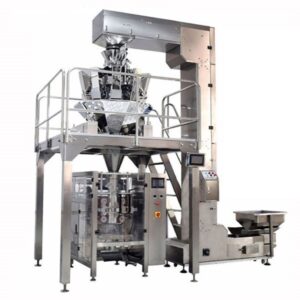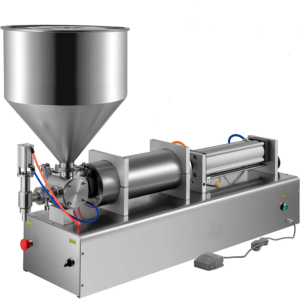Description
| Specification | Details |
|---|---|
| Filling Method | Volumetric |
| Capacity | Up to 1000 bottles per hour |
| Bottle Size Range | 50ml to 1000ml |
| Accuracy | ±0.5% |
| Material | Stainless steel |
| Power Supply | 220V, 50Hz |
| Power Consumption | 1.5 kW |
| Control System | PLC with touchscreen interface |
| Hopper Capacity | 50 liters |
| Operating Pressure | 0.4-0.6 MPa |
| Dimensions (LxWxH) | 1200mm x 800mm x 1800mm |
| Weight | 400 kg |
| Safety Features | Emergency stop button, Overload protection |
Overview of Volumetric Fillers
Volumetric fillers are machines that automatically put up an accurate amount of product in containers. These employ different mechanisms to measure and dispense products like liquids, powders, granules, or solids. They are widely utilized within industries wherein exactitude is a must to assure that the quality and consistency of the filled products are at their best.
Types of Volumetric Fillers
Piston Fillers: These devices draw product into a chamber by using pistons before delivering it to containers. They work well for dense or viscous fluids with high accuracy levels being achieved.
Auger Fillers: In these fillers, rotating auger screws help to determine the amount and release powdered or granulated elements. This compliments them as they can be applied in different types of containers for filling purposes.
Rotary Fillers: Their function is about measuring out and dispensing liquid or more particularly a highly viscous variety using revolving discs/valves with them. As such they may be used where there is a need for speed during manufacture since they would increase efficiency.
Gravity Fillers: Such kinds of fillers use gravity as a means for loading liquids into cans. The design is simple and suitable especially where thin liquid materials are involved.
Net Weight Fillers: Load cells or scales are used by net weight fillers to determine the quantity drawn into cans. Industries with significant emphasis on accurate weight control have adopted this technology widely.
Functions of Volumetric Fillers
Measurement: Filling volumetrically entails accurately approximating how much volume should go into each container.
Dispensing: After being measured, these filler machines have been programmed in such a way that they directly dispense the products with precision filling the containers uniformly.
Automation: Thereby reducing manual labor and enhancing production efficiency through automation filling method
Control: This gives operators more input into choosing settings that would satisfy specific requirements through volumetric fillers.
Integration: Several volumetric fillers can be placed into existing production lines to improve overall efficiency and productivity.
Working Process of Volumetric Fillers
The working process of volumetric fillers however may vary depending on the type of filler being used. But generally, it follows these steps:
Product Feeding: The product is fed into the filler manually or via an automated system
Measurement: It measures out the amount using a piston, auger, or gravity as its specific mechanism
Dispensing: After measurement, the product is dropped into containers either directly or through a conveyor system
Control and Monitoring: Accuracy and uniformity during filling are controlled by software in the filling machine
Integration: Some volumetric fillers have integration capability that allows them to interact with other machines in the line for seamless operation.
Applications of Volumetric Fillers
Volumetric fillers are used in various industries including:
Food and Beverage: These are meant for filling bottles, jars, pouches, and cans with liquids i.e. sauces and condiments, etc.
Pharmaceuticals: Used in vials/bottles/containers having medicines (tablets/capsules/powders)
Cosmetics: They can be found within tubes/bottles/jars containing creams/lotions/gels among other cosmetics products
Chemicals:Are ideal for drums/containers/bottles filled with chemicals/detergents/lubricants/solvents
Personal Care: To make containers full of shampoos/conditioners/body washes etc.
Advantages of Volumetric Fillers
Accuracy: For instance, by employing these devices one would come up with well-filled packs that have high accuracy levels. Although this method is considered more accurate people observe that particular volume required which must go inside every container.
Consistency: Automated control systems enable fillers to be used for consistent filling volumes, leading to lower product waste and improved quality.
Efficiency: These machines can bring about an increase in production efficiency by making the filling process automatic instead of manual, which also reduces manual work.
Versatility: Volumetric fillers can be used to serve a wide variety of products, containers, and filling quantities.
Cost-Effectiveness: They help reduce wastage and enhance efficiency making them a cost-effective way for packaging needs.
Hygiene and Safety: Many volumetric fillers come with some hygiene and safety features so as not to compromise product integrity as well as compliance with regulatory provisions.
Flexibility: Their usage cuts across various product types, container sizes, or volume demands hence they can easily be made suitable for any given need through adjustment.
Integration: The data sheet title “Volumetric Filler” should be seamlessly integrated into existing lines improving workflow across the entire plant.
Space-Saving.: The designs are meant to utilize small floor spaces within manufacturing facilities effectively thereby conserving space that can be put to other use such as storage.
Customization: This makes it easy for manufacturers to customize their volumetric filler machines according to specific needs enhancing their relevance in different operations
Benefits of Volumetric Fillers
Improved Product Quality – By ensuring perfect and uniform filled-up amount volumetric fillers contribute greatly towards the overall quality of packed product
Increased Productivity – Automation offered by volumetric fillers facilitates higher rates of production thus there is no need for increasing labor force size
Reduced Labor Costs – Manual intervention is kept at minimum levels due to which expenses associated with staffing requirements drop significantly down during particular operation
Enhanced Brand Reputation – Consistent packaging combined with accurate filling will contribute positively towards brand reputation thus leading to a high customer satisfaction level
Regulatory Compliance – Many volumetric fillers have been designed in a way that they meet the required industry regulations and standards hence complying with quality and safety requirements.
Adaptability to Market Changes – In other words, volumetric fillers may also be adjusted or modified according to changes in demand for the products, packaging formats, or even regulations that are there thereby making them very flexible to manufacturers
Sustainability.: Minimizing waste while maximizing the use of packaging material efficiency for sustainability within manufacturing operations can be attained by using volumetric fillers.
FAQs about Volumetric Fillers
What should I take into account when selecting a volumetric filler?
Product type for filling requires precision during the filling process, the amount of product being filled per unit of time, the size of containers being used as well and the cost involved are some factors that one should put into consideration while choosing this equipment.
Can there be corrosive or abrasive products handled by volumetric fillers?
Yes, indeed there exist volumetric fillers that have been specifically manufactured to handle corrosive and abrasive products which usually come along with protective covering materials or corrosion-resistant materials.
Are volumetric fillers suitable for small-scale production?
Yes because there are different sizes and configurations of such volumetric fillers found in the market so they can perfectly fit in both small and large scale production environments depending on what you want.
How do I maintain a volumetric filler?
For optimal performance, throughout all time it is important to regularly check cleanliness, and lubrication together with inspection involving each part of these instruments
Can volumetric fillers be integrated with other packaging machinery?
In most cases, they integrate well with other forms of packaging machinery like cappers, label applicators, and sealants among others to make up the complete automated production line.
What safety features do typical volumetric fillers include?
Safety comes first. For instance, stop buttons during emergency interlocks and guarding were among them this ensures good protection from accidents hence operator safety measures have been looked after thoroughly.”
How accurate are volumetric fillers in dispensing products?
It depends on the type of filler used and the items being processed, but most volumetric fillers are capable of achieving high levels of accuracy, typically within a few milliliters or grams.
Can volumetric fillers be used for hot-fill applications?
These kinds of filling machines have been made to cater to hot-fill applications whereby there are temperature control systems as well as materials that can effectively withstand heat.
Are volumetric fillers customizable to specific production requirements?
Yes, many companies allow their customers to customize volumetric filling machines according to product types, filling volumes, and container sizes.
What are some issues associated with volumetric fillers?
Such machines commonly encounter challenges such as foaming of the product, differing viscosities, product splashes, or frequent recalibrations for accuracy purposes.




